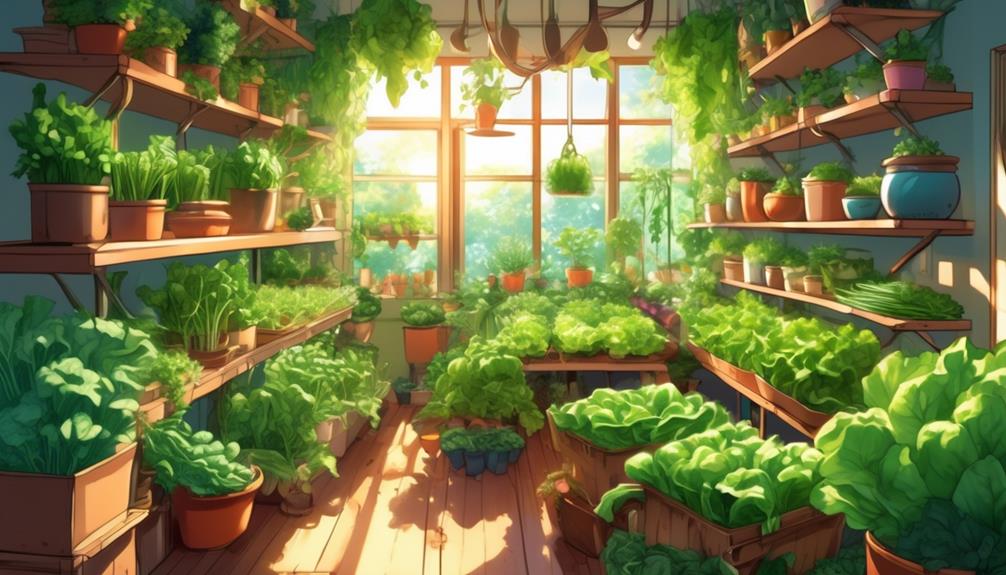Have you ever dreamed of having a lush, vibrant vegetable garden right in the comfort of your own home, providing you with a steady supply of fresh greens throughout the year?
Well, with a few tips and tricks up your sleeve, this dream can become a reality. In this discussion, we will explore some expert advice on how to successfully grow an indoor vegetable garden that will keep you stocked with delicious, nutrient-packed greens no matter the season.
So, if you’re ready to discover the secrets to year-round gardening success, keep reading to find out more.
Indoor Vegetable Garden Quick Tips…
- Leafy vegetables like spinach, kale, and arugula thrive in cooler temperatures and can be easily grown indoors.
- Warmth-loving vegetables like tomatoes, peppers, and strawberries can also be grown indoors with the right conditions.
- Herbs like basil, oregano, and rosemary can be grown indoors but require plenty of light and warmth.
- Select appropriate container sizes based on the plants being grown to ensure sufficient space for root growth.
Choosing the Right Plants
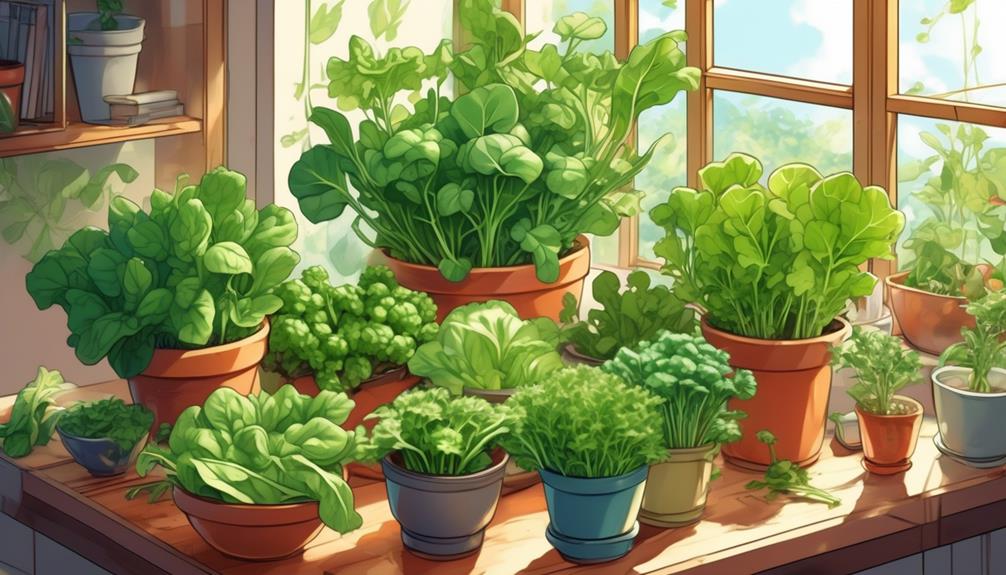
When selecting plants for your indoor vegetable garden, it’s important to consider their specific light and temperature requirements to ensure successful growth.
For year-round greens, leafy vegetables like spinach, kale, and arugula are excellent choices. These greens thrive in cooler temperatures and can be easily grown indoors.
On the other hand, if you desire warmth-loving vegetables, such as tomatoes, peppers, or strawberries, they can also be grown indoors with the right conditions. However, keep in mind that they require more heat and light compared to leafy greens.
If you’re interested in growing herbs, like basil, oregano, or rosemary, it’s absolutely possible, but it requires patience. These plants prefer plenty of light and warmth, so be sure to provide them with the appropriate conditions.
When selecting plants for your indoor vegetable garden, choose the appropriate container size based on the plants being grown. This ensures that the roots have enough space to grow and that the plants are stable. Additionally, using quality potting soil specifically designed for vegetables is crucial. It provides the necessary nutrients and drainage for successful growth.
To supplement natural light, consider using grow lights. These lights mimic sunlight and are essential for indoor gardening, especially in areas with limited natural light.
By considering the specific light and temperature requirements of different plants, you can choose the right plants for your indoor vegetable garden and ensure successful growth year-round.
Providing Ideal Growing Conditions
To provide ideal growing conditions for your indoor vegetable garden, it’s essential to create an environment that meets the specific needs of the plants being grown. When choosing plants for your indoor garden, opt for a variety of vegetables, herbs, and fruits suitable for indoor growth.
Leafy greens and herbs are excellent choices, as well as warmth-loving vegetables like tomatoes and peppers. Lighting is crucial for the growth of indoor plants. Depending on the specific needs of your plants, provide appropriate lighting ranging from low-medium to high intensity. This will ensure that your plants receive the right amount of light to thrive.
Good air circulation is also important, as it helps prevent diseases and ensures the proper exchange of gases. Maintain a humidity range of 40-50% to create the ideal growing conditions for your indoor crops. Consider using a humidifier or misting your plants with a spray bottle to maintain optimal humidity levels.
When it comes to containers, use pots with drainage holes and saucers or drip trays. This will regulate water levels and prevent waterlogging, which can lead to root rot. Choose a well-draining potting soil mix specifically designed for indoor plants. This will provide the necessary nutrients and moisture retention for your plants. Lastly, when starting your indoor garden from seeds, ensure that you follow the seed packet instructions regarding planting depth, watering, and light requirements.
Selecting the Proper Lighting
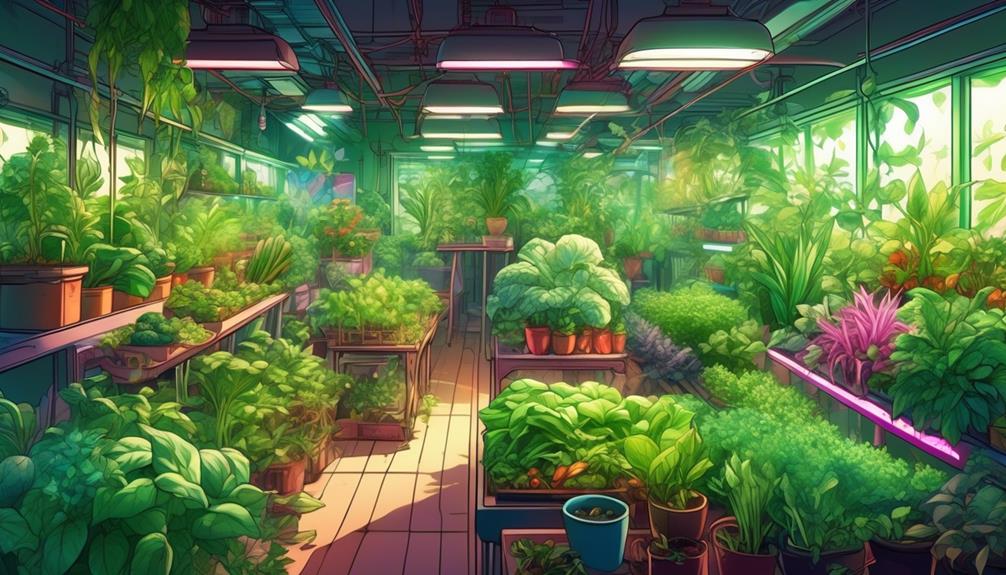
To ensure optimal growth for your indoor vegetable garden, selecting the proper lighting is crucial. Plants need light to grow, and when grown indoors, they rely solely on the light you provide.
When choosing the right lighting for your indoor garden, consider the light needs of different plants. Some plants, like leafy greens and herbs, require low to medium light, while others, such as tomatoes and peppers, need high light levels.
There are several lighting options available for indoor gardens.
Fluorescent shop lights and CMH grow lights are recommended for warmth-loving crops. These lights provide the necessary spectrum and intensity for plants to thrive. If you have access to natural light, combining it with artificial grow lights can yield even better results.
When selecting your lighting, factors like cost, electrical consumption, and quality should be taken into account. Adjustable lights are ideal, as they can be positioned close to the plants for maximum benefit. It’s important to ensure that your chosen lighting provides at least 12 hours of light per day for optimal growth. During the short winter months, supplemental lighting may be needed to compensate for the reduced daylight.
Proper lighting is essential for healthy indoor vegetable growth. Insufficient light can result in yellow or leggy plants, while plants with full access to light exhibit vibrant color and sturdy stems. By selecting the right lighting for your indoor vegetable garden, you can provide the ideal conditions for a variety of vegetables to grow and thrive year-round.
‘Did you know? Some studies have shown that certain colors of light, such as red and blue, can promote specific stages of plant growth. For example, red light can encourage flowering, while blue light can enhance vegetative growth. Experimenting with different light spectrums can help optimize your indoor garden’s productivity.’
Using the Right Potting Mix
Now that you have selected the proper lighting for your indoor vegetable garden, it’s time to discuss the next important step: using the right potting mix. The potting mix you choose plays a crucial role in providing the necessary growing conditions for your indoor plants. Here are four key things to consider when selecting a potting mix for your indoor vegetable garden:
- Choose an organic, all-purpose potting mix: Look for a potting mix that’s specifically formulated for indoor gardening. An organic mix ensures that your plants receive the nutrients they need without harmful chemicals.
- Avoid using soil from your outdoor garden: Outdoor soil may contain pests, diseases, or weed seeds that can harm your indoor plants. It’s best to use a soilless potting mix for your indoor garden.
- Look for a soilless potting mix with peat moss, vermiculite, and perlite: These ingredients help to create a lightweight and well-draining mix. Peat moss retains moisture, vermiculite improves aeration, and perlite prevents compaction.
- Mix your own basic soilless potting mix with specific ratios: If you prefer a DIY approach, you can create your own potting mix by combining peat moss, vermiculite, and perlite in specific ratios. Consult a gardening guide or expert for recommended proportions.
Remember to regularly check the moisture levels of your potting mix and provide proper water and liquid fertilizer for your young plants. By using the right potting mix, you can create a thriving indoor vegetable garden that provides year-round greens, regardless of sun exposure.
‘Did You Know? The concept of using potting mix for indoor gardening dates back to ancient Mesopotamia, where the Hanging Gardens of Babylon were renowned for their lush vegetation. The Babylonians used a mixture of sand, clay, and organic materials to create a suitable growing medium for their plants.’
Watering and Humidity Control
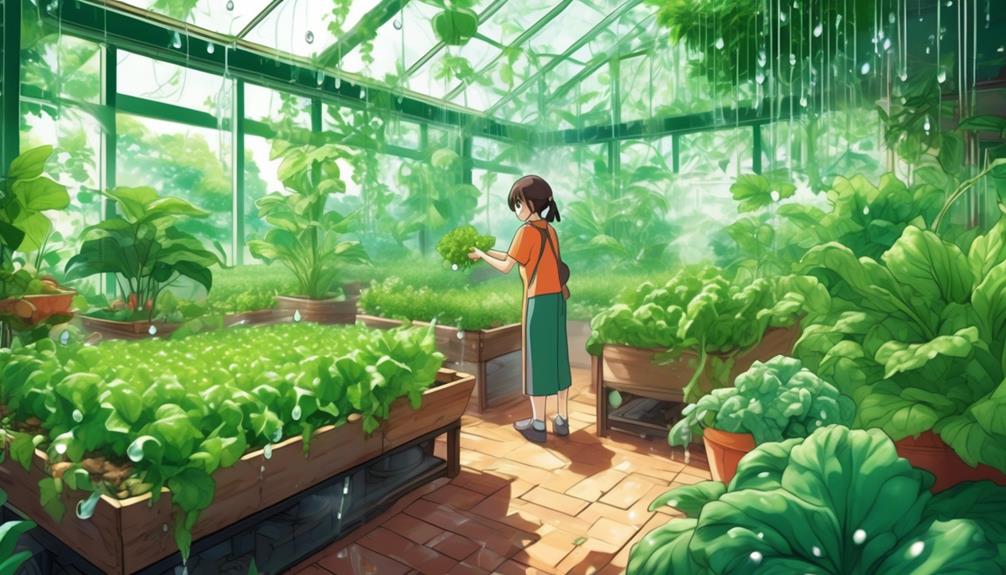
Maintaining the proper watering and humidity levels is essential for the success of your indoor vegetable garden. When it comes to watering, it’s important to strike a balance. Overwatering can lead to root rot and other issues, while underwatering can stunt plant growth. Use a watering can with a long, narrow neck to water the soil directly, avoiding excessive moisture on the leaves. This helps prevent the growth of mold and fungus.
In addition to proper watering, humidity control is equally important. Most indoor crops thrive in humidity levels between 40-50%. To increase humidity, especially during dry winter months, mist your plants daily with a spray bottle. This will provide the necessary moisture for healthy growth. If you want a more automated solution, invest in misters that can be set to maintain consistent humidity levels.
Good air circulation is crucial for your indoor vegetable garden. It helps prevent pests, mold, and fungus growth. To achieve this, consider using an electric fan on a mechanical timer. This will ensure that your plants have access to fresh air and prevent stagnation. Remember to periodically clean the fan to remove any dust or debris that may hinder its effectiveness.
‘Did you know? The Hanging Gardens of Babylon, one of the Seven Wonders of the Ancient World, were believed to have used an intricate system of aqueducts and irrigation to water the lush vegetation, showcasing the importance of proper watering techniques even in ancient times.’
Ensuring Adequate Air Circulation
Achieving optimal air circulation is crucial for the health and vitality of your indoor vegetable garden, allowing plants to thrive while preventing the growth of pests, mold, and fungus. Here are four important tips to ensure adequate air circulation for your indoor vegetable garden:
- Place an electric fan on a mechanical timer: A fan can provide consistent air movement, which is essential for preventing pest infestations and maintaining healthy plants. By placing the fan on a timer, you can ensure that the plants receive the necessary airflow without overexposing them.
- Mist plants daily or use automated misters: Mist your plants daily with a spray bottle or use automated misters to maintain adequate humidity and promote air circulation. This will help prevent the growth of mold and fungus while also keeping the plants hydrated.
- Water directly at the soil level: When watering your indoor vegetable garden, use a watering can with a long, narrow neck to water the soil directly. This ensures that the plants receive proper hydration while also aiding in air circulation.
- Boil and cool tap water or use distilled water: To avoid mineral buildup and support healthy air circulation, it’s recommended to boil and cool tap water or use distilled water when needed. This will help maintain the overall health of your indoor vegetable garden.
Did you know? Proper air circulation not only benefits plants but also improves indoor air quality, making your living space healthier and more comfortable.
Maintaining and Harvesting Greens
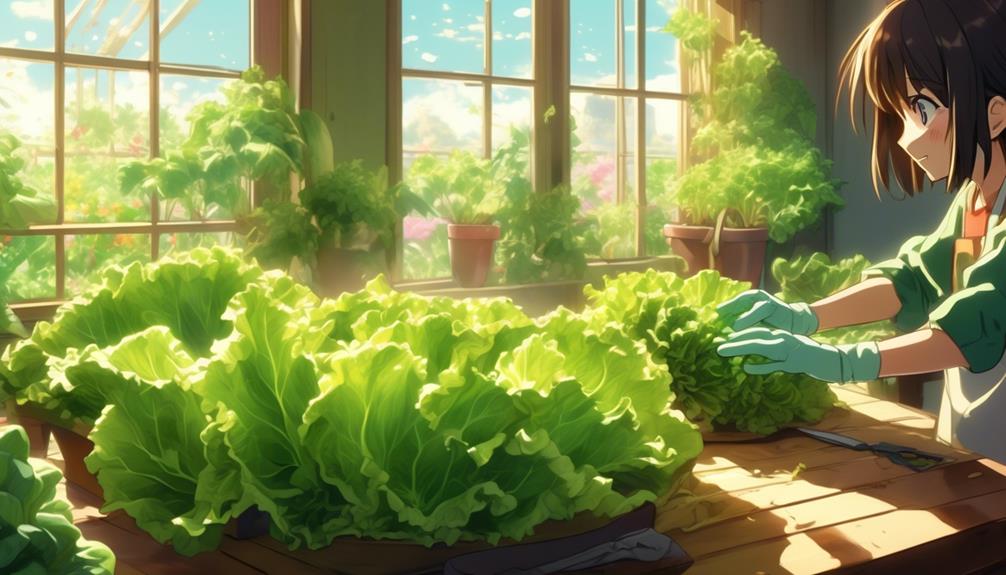
To ensure the continuous growth and optimal flavor of your indoor vegetable garden greens, it’s important to regularly harvest the outer leaves of leafy greens like spinach and kale. This not only encourages new growth, but also prevents bolting, which is when the plant prematurely produces flowers and stops producing leaves.
When harvesting leafy greens, such as lettuce and arugula, it’s best to use sharp scissors to snip off the outer leaves. This allows the inner leaves to continue growing and ensures a steady supply of fresh greens.
When it comes to herbs like basil and oregano, harvesting the top leaves promotes bushier growth and ample harvests. Simply pick the top leaves, and the plant will respond by producing more leaves for future harvests.
For warmth-loving vegetables like peppers and tomatoes, it’s important to keep an eye on their maturity. Pick them when they’re fully ripe for the best flavor. Harvesting them at the right time ensures that you enjoy the fruits of your labor when they’re at their peak in terms of taste and texture.
To maintain the health of your plants and ensure continuous harvests, it’s also a good practice to rotate your harvest. This means giving plants time to recover and regrow before harvesting from the same spot again. This helps prevent depletion of nutrients and promotes overall plant health.
“Did You Know? In ancient Rome, lettuce was considered a symbol of sexual prowess, and it was believed to have aphrodisiac properties. It was even served at weddings to promote fertility and passion.”
Tips for Year-Round Indoor Gardening
For successful year-round indoor gardening, it’s essential to have a variety of plants that can thrive in an indoor environment. Here are some tips to help you on your journey of growing vegetables indoors:
- Start by growing vegetables that are known to grow well indoors, such as leafy greens like lettuce, spinach, and kale. These plants are perfect for indoor gardening because they grow quickly and can be harvested by cutting the outer leaves, allowing the plant to continue growing.
- Group plants by similar heights to ensure that they receive an equal amount of light. This will help prevent taller plants from shading out shorter ones. You can also rotate the plants regularly to ensure that each side receives adequate light.
- Use containers with drainage holes to prevent waterlogging. This will help maintain proper moisture levels and prevent root rot. Fill the containers with a growing medium that includes peat moss, which retains moisture while still allowing for proper drainage.
- Pay attention to the lighting needs of your plants and provide appropriate artificial lighting if needed. LED grow lights are a popular choice for indoor gardening due to their energy efficiency and ability to provide the right spectrum of light for plant growth.
In Summary…
Growing an indoor vegetable garden for year-round greens requires careful attention to plant choices, supplies, and growing conditions.
With the right knowledge and techniques, you can enjoy a bountiful supply of fresh greens throughout the year, right from the comfort of your own home. So why not give it a try and experience the joy of homegrown vegetables all year long.
